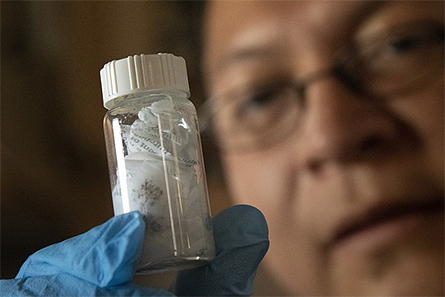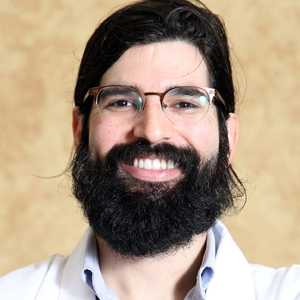Putting body weight in context
When we step into a doctor’s office, the first step we take is onto a scale. That’s before talking with a clinician, before a blood pressure or temperature check, and certainly before we tell our story, the symptoms bringing us to the doctor’s threshold. Sometimes it seems there’s a scale between us and our care. The architecture of the clinic declares that our health is determined first and foremost by our weight, and often, basic science recapitulates and reinforces this framework.

I write about scientific and medical fatphobia as a student, a young scientist and an intermittently fat person. I didn’t expect to start seeing the intersections of fatphobia with environmental racism or police violence. I didn’t expect to see them in my medical school classes. Or in my own care. I didn’t think about this issue at all until recently. But once you start seeing the redundant harms larger people are exposed to, it’s hard to stop.
Let’s start with biology
This is the easy part, the pre-political part. I admire adipose tissue. It stores free fatty acids as triglycerides, safeguarding this fuel source for moments of need. Free fatty acids are also powerful signaling molecules, the basis of both anti- and pro-inflammatory cascades. Adipose tissue shields the body from unregulated contact with these molecules; it participates with the nervous system in their careful and regulated release, the process of lipolysis I study every day.

On a macroscopic scale, fat acts as a biomechanical cushion. From the backs of our eyes to the joints of our knees, it prevents acute trauma. Fat is also part of our immune system: The greater omentum, one of the visceral fat pads thought to play a role in cardiovascular disease, hunts down infections and cancers in the peritoneal cavity, walling them off until they are resolved. Adipocytes, the functional units of fat tissue, line our blood vessels, helping to maintain normal blood pressure. Fat tissue communicates with the brain through hormones called adipokines and through sensory nerves, apprising us of our nutrient status.
Adipose tissue is essential for life. Mice engineered to lack adipose are lean but die young, destined for fatty liver disease and diabetes. Conversely, in humans, all-cause mortality is as high in underweight people (as defined by body mass index) as it is in patients with higher BMIs. In conversations about this topic, one question comes up above all others: “Aren’t very thin people typically experiencing another disease process, only indirectly related to their weight?” This kind of skeptical inquiry is critical; indeed, low body mass is associated with many pathologic processes, including cancer cachexia and other terminal conditions. For a thin person, the average scientist and physician believes that cancer, not thinness, is killing that patient. They can locate the source of mortality in something other than body weight or adipose stores. What scientific reason prevents them from extending the same courtesy to larger people?
Fat defines fat people
Fat comes first. First in the doctor’s office, first in the scientific literature. Fat is never incidental in a fat person’s body. Every other pathology must somehow be linked to it, and all disease processes in a fat person can be improved by weight loss. This is the dominant paradigm. After all, we think we know what fat does when it hurts us: hypertension, diabetes, cancers, immunosuppression, even a tendency to lie, according to a recent article in Scientific Reports. Notably, this article has been retracted. Can we say the same of the scientific milieu that made its peer review and publication possible?
When body weight is on the scale, we seem incapable of remembering the first rule of statistics: Correlation is not causation. Our language often reflects this failure: “Diet-induced obesity causes x, y or z outcome in mice,” “Weight-loss trials demonstrate improved insulin sensitivity in patients.” My research-methods professor taught me that to claim causation, something should be manipulated. Because I want to understand adipose, I started paying attention to all the studies that claim it plays a key role in one or another pathophysiologic process. I slowly began to realize they all were manipulating something else: diet, exercise, drug exposure. These manipulations also, often, produce changes in adiposity: sometimes weight loss, sometimes weight gain. No matter what, however, the downstream benefits and harms were attributed to weight changes, not to the manipulation. Fat doesn’t get to be a correlate; it’s all causation, all the time.
Liposuction studies are the rare exception. Liposuction removes adipose tissue acutely and specifically. And there is no clear metabolic benefit. Because most liposuction is cosmetic, it involves the removal of subcutaneous fat. Metabolism-savvy readers know, however, that the accumulation of visceral fat is more strongly associated with disease on an epidemiological level. As such, perhaps we should expect that the removal of visceral fat, not subcutaneous fat, will improve health. Strikingly, a recent meta-analysis showed that the removal of omental fat, a large visceral fat pad, on its own or in conjunction with bariatric surgery, does not have clear metabolic benefits.
Fat can be dysfunctional
Like any tissue, fat can play a role in disease. I read this literature carefully; as such, I was interested in a recent report showing that removal of mesenteric fat (which lines the intestines) can improve insulin resistance in primates. But we don’t call hypertension “kidney-associated high blood pressure.” We recognize that hypertension mechanistically occurs due to a constellation of complex factors connecting kidneys, vasculature, the nervous system and, yes, adipose tissue.

stained green. The fat cell layer forms the final barrier against bacteria
entering deep into the body. The number of fat cells in the skin decreases
with age, making the skin more susceptible to infection.
As a researcher, I’d like to extend that same curiosity to diseases such as diabetes and conditions such as insulin resistance, those phenomena most intimately correlated with adiposity on a population level. But when we write papers on metabolic disease, we call high-fat diet “diet-induced obesity,” and whatever else happens in those models often is considered downstream of the weight gain. Thousands of research projects use this most common model of metabolic disease, the rough equivalent of eating two sticks of butter a day. This model drives brain inflammation, alters the microbiome and induces hypertension, along with myriad other pathologies. Rarely are these other effects presumed to be the dominant, upstream factor. The model is called “diet-induced obesity,” and that choice reflects our belief that adiposity is the fundamental cause of the rest of the constellation.
Fear of fat
My father has Type 2 diabetes, as did his grandmother. Weight was a central fact of their lives. My father remembers conversations about body weight from as early as his fifth year of life. By his 50th, when he was diagnosed with diabetes, metformin already was approved for use in the United States. Initially, he didn’t take it, opting instead to increase his exercise and change his eating patterns. He felt he had earned his metabolic disease; it was his obligation to pay that bill.
That doesn’t tell the whole story, however. When I asked my father years later why he waited so long to accept a frontline medication, he explained to me that it caused weight gain. That belief was not accurate, but his fear of fatness had its own causal power. My father was afraid of the medicine that would have ameliorated the insulin resistance underlying his disease. He attributed that disease to his adiposity, and, in a bizarre twist, he feared that medicine for diabetes would somehow worsen diabetes by worsening his adiposity.
In reading the landmark work of Sabrina Strings, a sociologist at the University of California, Irvine, studying the intersection of racism and fatphobia, I came to realize that avoiding medicines for fear of weight gain was not a rare behavior but potentially a common one. Strings first observed this pattern in people with HIV/AIDS who chose not to take lifesaving anti-retroviral medication due to fear of weight gain.
My father and I had our conversation walking in Audubon Park in New Orleans shortly after he was discharged from the hospital for a geriatric onset of a severe autoimmune disease. He was cachectic but recovering, in a wholly unexpected medical miracle. He told me it was nice not to worry about “those kinds of things anymore.” When I asked him what he meant, he explained calmly: He was finally thin.
I’ve been both fat and thin in my life. I’ve been hospitalized for a gastroenterological problem and have seen “obesity” in my chart. It didn’t feel good — nor did the curt, and incorrect, admonishment from a fellow medical student that I shouldn’t be looking in my own chart. We never did learn what caused my illness, neither during the first nor the second hospitalization. I offered my own theory: serious psychosocial stress brought on by the strain from illness in the family, medical school and the recent loss of a dear friend. That didn’t garner much interest. I don’t think I received substandard care, but I know “obesity” was in my chart. And I know the profound emotional pain I was experiencing wasn’t. Whether in an article title or a medical chart, what we record reflects what we value and what we imagine to be reasonable causes of disease.
Chronic disrespect
Medical provider bias against larger people is endemic. In a survey of 4,732 first-year medical students, approximately two-thirds endorsed explicit biases against fat people. Where do they learn those attitudes? I know that some studies show mortality in larger people with high cardiovascular fitness is no different than in lean people who do not exercise, but I didn’t learn that in class. In medical school, I was taught a different, seemingly fundamental truth: “Let’s be honest and straightforward here. Most people are obese because they eat too much. Period, moving on, next sentence.”
I play that audio back for myself sometimes; its blaming bigotry is so plain, so jarring and so unthinking. We should worry deeply about the effects of that kind of bias, offered with neither shame nor awareness, on our understanding of human illness. I heard those words in Alabama, a state marked by extreme inequity and extreme health disparities. That context was missing. Period. Moving on. Next sentence.
Missing pieces

a grant in 2018 to develop biosensors for glucose and bisphenol compounds,
endocrine disruptors found in receipts from thermal printers and certain plastic
bottles and containers.
I care about preventing and treating diabetes. Most of our preclinical research on diabetes focuses on dietary causes. I use these research models too; they have great utility at times. High-profile journals publish hundreds of articles a year on high-fat diet. These models are good at making mice gain weight, but I fear they are missing essential pieces of the puzzle.
Most major journals never have published an article on an endocrine disruptor, though these molecules are endemic, though we can readily expose mice to them, though they induce metabolic diseases readily and though they are inequitably distributed — from bisphenol A–lined receipts that selectively poison the blood of grocery store clerks to the smokestacks of the 35th Avenue Superfund site in my own city, Birmingham, Alabama. Inequitable exposure is not the exception; it’s the rule.
Comparably, drinking water at prisons in the southwest United States contains unusually high levels of arsenic. Arsenic is a classic beta islet cell toxin, and beta islet cell dysfunction is a necessary event in the transition from insulin resistance to frank diabetes. Where is the research on the epidemic of public poisoning that plays a likely role in exacerbating metabolic disease? Will our research agenda serve these most marginalized members of our society?

Taking responsibility
The models and frameworks used in biomedical research teach us that disease happens to individuals, not communities. We largely understand body weight to reflect an individual dietary choice, and our country builds public policy on that premise. This framework obscures the health impacts of structural violence, whether pollution, chronic stress, neighborhood segregation and disinvestment, or any other mechanism of nonconsensual harm.
I began seriously considering this problem during the intersection of the COVID-19 pandemic and the uprisings for racial justice in the summer of 2020. At that time, I was struck by a publication showing that police violence predicted the incidence of various components of metabolic syndrome, including adiposity.
In marked contrast, Bill Cassidy, a United States senator and medical doctor, attributed racial disparities in COVID-19 rates to preexisting conditions, claiming that systemic racism was only rhetoric and concluding, “As a physician, I’m looking at science.” He did not consider the possibility that inequity is a fundamental cause of those preexisting conditions. That wasn’t what he saw in the science, or what he was willing to recognize as science.
The readers of ASBMB Today are scientists. I advocate that we, as scientists, think critically about how our understandings of health and disease are used. The research we do, and the research we don’t, informs or delays policy actions to address health inequities. Grappling with that truth should fall under the responsible conduct of research. That’s all I’m in pursuit of: taking responsibility for the work I do, doing that work responsibly, being responsive to the communities affected by the illnesses I study and how I study them.
It’s time to reimagine body weight, a reimagining best achieved by listening to people harmed by the status quo. Their voices share so much context: lifetimes of fear and disrespect. Voices calling for a more equitable society, free from public poisonings, free from police violence. They are calling for context. Perhaps it’s time our research agendas put body weight in it.
Enjoy reading ASBMB Today?
Become a member to receive the print edition four times a year and the digital edition monthly.
Learn moreGet the latest from ASBMB Today
Enter your email address, and we’ll send you a weekly email with recent articles, interviews and more.
Latest in Opinions
Opinions highlights or most popular articles

The tortoise wins: How slowing down saved my Ph.D.
Graduate student Amy Bounds reflects on how slowing down in the lab not only improved her relationship with work but also made her a more productive scientist.

How pediatric cataracts shaped my scientific journey
Undergraduate student Grace Jones shares how she transformed her childhood cataract diagnosis into a scientific purpose. She explores how biochemistry can bring a clearer vision to others, and how personal history can shape discovery.

Debugging my code and teaching with ChatGPT
AI tools like ChatGPT have changed the way an assistant professor teaches and does research. But, he asserts that real growth still comes from struggle, and educators must help students use AI wisely — as scaffolds, not shortcuts.

AI in the lab: The power of smarter questions
An assistant professor discusses AI's evolution from a buzzword to a trusted research partner. It helps streamline reviews, troubleshoot code, save time and spark ideas, but its success relies on combining AI with expertise and critical thinking.

How AlphaFold transformed my classroom into a research lab
A high school science teacher reflects on how AI-integrated technologies help her students ponder realistic research questions with hands-on learning.

Writing with AI turns chaos into clarity
Associate professor shares how generative AI, used as a creative whiteboard, helps scientists refine ideas, structure complexity and sharpen clarity — transforming the messy process of discovery into compelling science writing.

